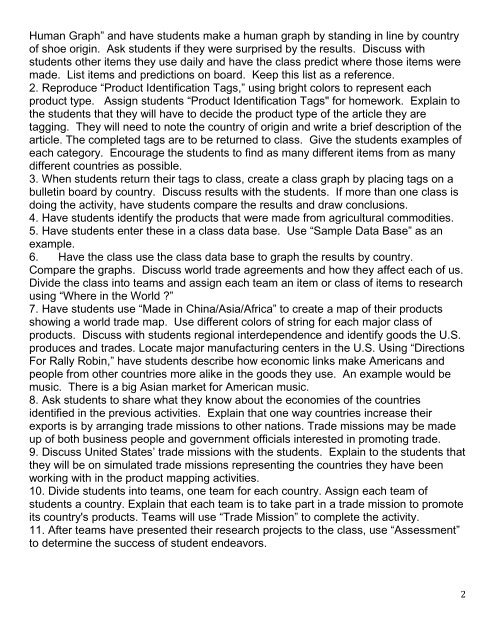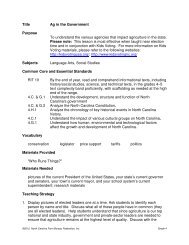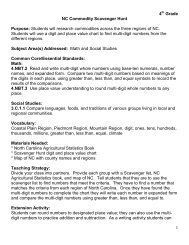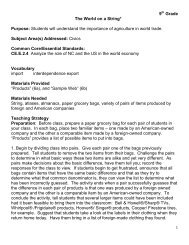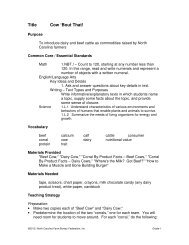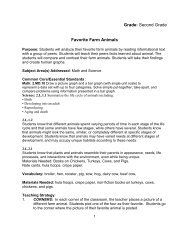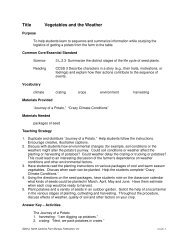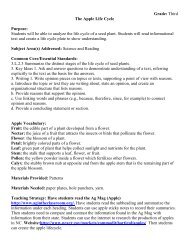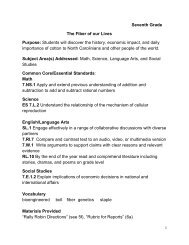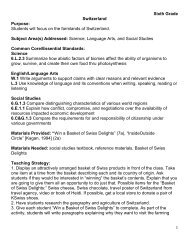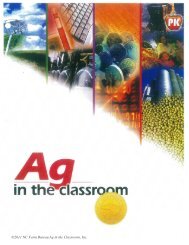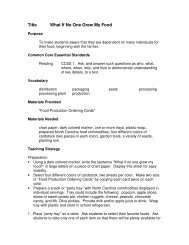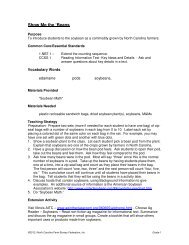Lesson Plan 10 – We are All in this Together - Ag in the Classroom
Lesson Plan 10 – We are All in this Together - Ag in the Classroom
Lesson Plan 10 – We are All in this Together - Ag in the Classroom
- No tags were found...
You also want an ePaper? Increase the reach of your titles
YUMPU automatically turns print PDFs into web optimized ePapers that Google loves.
Human Graph” and have students make a human graph by stand<strong>in</strong>g <strong>in</strong> l<strong>in</strong>e by countryof shoe orig<strong>in</strong>. Ask students if <strong>the</strong>y were surprised by <strong>the</strong> results. Discuss withstudents o<strong>the</strong>r items <strong>the</strong>y use daily and have <strong>the</strong> class predict where those items weremade. List items and predictions on board. Keep <strong>this</strong> list as a reference.2. Reproduce “Product Identification Tags,” us<strong>in</strong>g bright colors to represent eachproduct type. Assign students “Product Identification Tags" for homework. Expla<strong>in</strong> to<strong>the</strong> students that <strong>the</strong>y will have to decide <strong>the</strong> product type of <strong>the</strong> article <strong>the</strong>y <strong>are</strong>tagg<strong>in</strong>g. They will need to note <strong>the</strong> country of orig<strong>in</strong> and write a brief description of <strong>the</strong>article. The completed tags <strong>are</strong> to be returned to class. Give <strong>the</strong> students examples ofeach category. Encourage <strong>the</strong> students to f<strong>in</strong>d as many different items from as manydifferent countries as possible.3. When students return <strong>the</strong>ir tags to class, create a class graph by plac<strong>in</strong>g tags on abullet<strong>in</strong> board by country. Discuss results with <strong>the</strong> students. If more than one class isdo<strong>in</strong>g <strong>the</strong> activity, have students comp<strong>are</strong> <strong>the</strong> results and draw conclusions.4. Have students identify <strong>the</strong> products that were made from agricultural commodities.5. Have students enter <strong>the</strong>se <strong>in</strong> a class data base. Use “Sample Data Base” as anexample.6. Have <strong>the</strong> class use <strong>the</strong> class data base to graph <strong>the</strong> results by country.Comp<strong>are</strong> <strong>the</strong> graphs. Discuss world trade agreements and how <strong>the</strong>y affect each of us.Divide <strong>the</strong> class <strong>in</strong>to teams and assign each team an item or class of items to researchus<strong>in</strong>g “Where <strong>in</strong> <strong>the</strong> World ?”7. Have students use “Made <strong>in</strong> Ch<strong>in</strong>a/Asia/Africa” to create a map of <strong>the</strong>ir productsshow<strong>in</strong>g a world trade map. Use different colors of str<strong>in</strong>g for each major class ofproducts. Discuss with students regional <strong>in</strong>terdependence and identify goods <strong>the</strong> U.S.produces and trades. Locate major manufactur<strong>in</strong>g centers <strong>in</strong> <strong>the</strong> U.S. Us<strong>in</strong>g “DirectionsFor Rally Rob<strong>in</strong>,” have students describe how economic l<strong>in</strong>ks make Americans andpeople from o<strong>the</strong>r countries more alike <strong>in</strong> <strong>the</strong> goods <strong>the</strong>y use. An example would bemusic. There is a big Asian market for American music.8. Ask students to sh<strong>are</strong> what <strong>the</strong>y know about <strong>the</strong> economies of <strong>the</strong> countriesidentified <strong>in</strong> <strong>the</strong> previous activities. Expla<strong>in</strong> that one way countries <strong>in</strong>crease <strong>the</strong>irexports is by arrang<strong>in</strong>g trade missions to o<strong>the</strong>r nations. Trade missions may be madeup of both bus<strong>in</strong>ess people and government officials <strong>in</strong>terested <strong>in</strong> promot<strong>in</strong>g trade.9. Discuss United States’ trade missions with <strong>the</strong> students. Expla<strong>in</strong> to <strong>the</strong> students that<strong>the</strong>y will be on simulated trade missions represent<strong>in</strong>g <strong>the</strong> countries <strong>the</strong>y have beenwork<strong>in</strong>g with <strong>in</strong> <strong>the</strong> product mapp<strong>in</strong>g activities.<strong>10</strong>. Divide students <strong>in</strong>to teams, one team for each country. Assign each team ofstudents a country. Expla<strong>in</strong> that each team is to take part <strong>in</strong> a trade mission to promoteits country's products. Teams will use “Trade Mission” to complete <strong>the</strong> activity.11. After teams have presented <strong>the</strong>ir research projects to <strong>the</strong> class, use “Assessment”to determ<strong>in</strong>e <strong>the</strong> success of student endeavors.2


